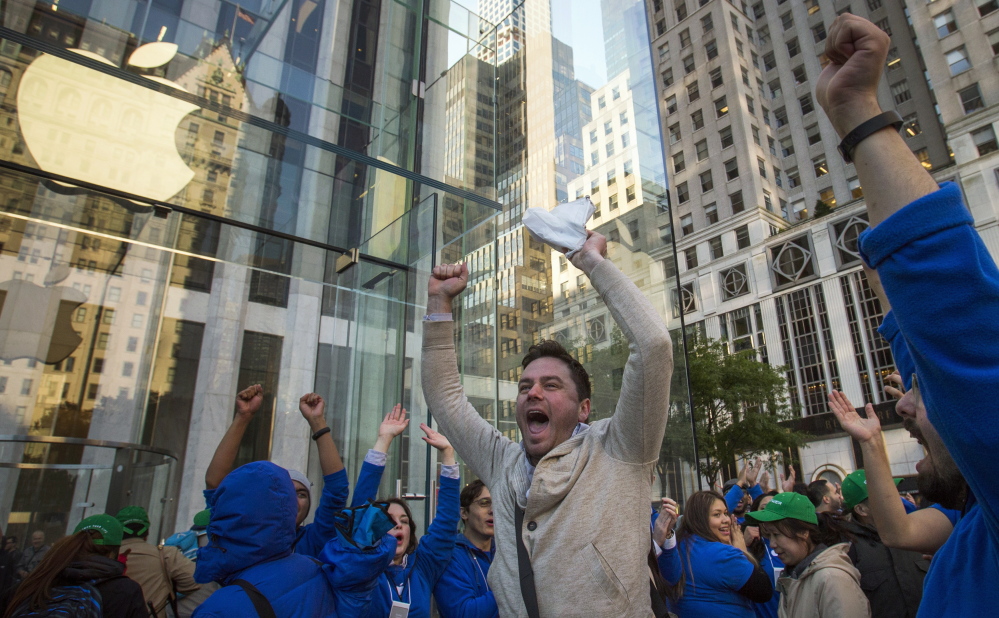NEW YORK — The big money doubted Apple this year. Oops.
“It’s been a really confusing year,” Kim Forrest, an analyst at Fort Pitt Capital Group Inc., which oversees about $1.7 billion in Pittsburgh, said in a phone interview. “There have just been a handful of stocks that drove the market and Apple was obviously one of them. It’s been tough.”
Aversion to the iPhone maker is turning out to be one of the worst blunders in 2014 for money managers, who are trailing benchmark indexes by the most in almost a decade. Shares of the world’s largest company rose four times more than the Standard & Poor’s 500 Index as Chief Executive Officer Tim Cook’s product plans eased concern over the company’s future growth.
Investors who clung to winners from the first five years of the bull market, from Internet companies to small caps, got burned in the sixth as chipmakers, utilities and dividend shares rallied.
In many ways, 2014 was the year of the hated stock. One of the best things you could’ve done was own companies with the highest short interest and the lowest analyst rankings, according to data compiled by Bloomberg. Such a strategy would have steered you to Exelon and Micron Technology, with average gains of 26 percent since January.
Going against the grain now would lead you to buy energy shares, the industry whose 2014 loss is triple the next worst-performing group in the S&P 500. That’s what Bill Nygren is doing after his $6.7 billion Oakmark Select Fund beat 97 percent of its peers this year. Nygren bought Apache Corp., a Houston-based oil producer, during the energy selloff as crude went from $107 a barrel to $58 in the past six months.
“Unloved companies tend to be the most interesting hunting ground for future outperformance,” Nygren, based in Chicago, said by phone. “The reason that Intel and Microsoft were able to do so well is that they were so unpopular.”
Like their colleagues in the bond market, many equity managers entered the year believing economic growth would pick up and interest rates rise. They avoided defensive stocks such as power generators and loaded up on retailers and other industries that benefit when Americans spend money on nonessential goods.
Instead of rising, yields on 10-year Treasury notes fell to 2.08 percent from 2.88 percent a year earlier, as central banks from Europe and Japan boosted monetary stimulus in a bid to spur growth. That fueled a surge of at least 20 percent in utilities and REITs, two groups whose dividends are among the highest. Consumer discretionary shares rose half as fast as the rest of the market.
Along with Cupertino, California-based Apple, Intel in Santa Clara, California, and Redmond, Washington-based Microsoft, account for 22 percent of the S&P 500’s 154-point advance so far this year after rallying an average of 34 percent. None was a consensus pick of money mangers, according to data compiled by Goldman Sachs.
As a consequence, eight of 10 funds focusing on large growth stocks are trailing their benchmark, the second-highest proportion since 2004, data compiled by Chicago-based Morningstar Inc. show.
About 87 percent of funds that purchase the biggest value shares gained less than their benchmark measure, as did almost 90 percent of the mid-cap funds.
At various points in 2014, the year was shaping up as the hardest in a decade to find stocks that generated alpha, the fund-industry term for gains above the market’s return. During the 12 months through September, only 30 percent of companies in the S&P 1500 posted gains that exceeded the large-cap gauge, the fewest since 1999, data compiled by Leuthold Group LLC show.
Copy the Story LinkSend questions/comments to the editors.



Success. Please wait for the page to reload. If the page does not reload within 5 seconds, please refresh the page.
Enter your email and password to access comments.
Hi, to comment on stories you must . This profile is in addition to your subscription and website login.
Already have a commenting profile? .
Invalid username/password.
Please check your email to confirm and complete your registration.
Only subscribers are eligible to post comments. Please subscribe or login first for digital access. Here’s why.
Use the form below to reset your password. When you've submitted your account email, we will send an email with a reset code.